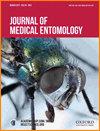Culex erraticus (Diptera: Culicidae) utilizes gopher tortoise burrows for overwintering in North Central Florida
IF 2
3区 农林科学
Q1 ENTOMOLOGY
引用次数: 0
Abstract
Mosquito-borne diseases represent a significant threat to human and animal health in the United States. Several viruses, including West Nile, Saint Louis encephalitis, and Eastern equine encephalitis are endemic. In humans, the disease is typically detected during the summer months, but not during the winter months. The ability of these viruses to reemerge year after year is still not fully understood, but typically involves persistence in a reservoir host or vector during periods of low transmission. Mosquito species are known to overwinter at different life stages (adults, larvae, or eggs) in manufactured or natural sites. Gopher tortoise burrows are known to serve as refuge for many vertebrate and invertebrate species in pine savannas. In this study, we surveyed the interior of gopher tortoise burrows for overwintering mosquitoes. We identified 4 species (Anopheles crucians s.l., Culex erraticus, Mansonia dyari, and Uranotaenia sapphirina). Cx. erraticus was the most abundant, and its presence and abundance increased in winter months, implying that this species utilized gopher tortoise burrows for overwintering. Bloodfed Cx. erraticus and An. crucians s.l. females were detected. While An. crucians s.l. fed exclusively on the white-tailed deer, Cx. erraticus had a more diverse host range but fed primarily on the gopher tortoise. Tortoises and other long-lived reptiles like the American alligator have been shown to sustain high viremia following West Nile virus (WNV) and Eastern equine encephalitis virus (EEEV) infection and therefore could play a role in the maintenance of these viruses. In addition, Cx. erraticus is naturally infected with WNV and is a known bridge vector for EEEV. As such, these overwintering sites may play a role in perpetuating over-winter arboviral activity in Florida.二带喙库蚊(双翅目:库蚊科)在佛罗里达州中北部利用地鼠龟洞穴越冬
在美国,蚊子传播的疾病对人类和动物健康构成重大威胁。包括西尼罗河病毒、圣路易斯脑炎和东方马脑炎在内的几种病毒是地方病。人类通常在夏季发现疾病,而冬季则不会发现。这些病毒年复一年重新出现的能力还不完全清楚,但通常是在传播率低的时期持续存在于宿主或病媒体内。据了解,蚊子物种会以不同的生命阶段(成虫、幼虫或卵)在人工或自然场所越冬。地鼠龟洞穴是松树稀树草原中许多脊椎动物和无脊椎动物的避难所。在这项研究中,我们调查了地鼠陆龟洞穴内部的越冬蚊子。我们确定了 4 个物种(鲫疟蚊、厄尔拉地库蚊、Mansonia dyari 和 Uranotaenia sapphirina)。呃逆库蚊的数量最多,其存在和数量在冬季都有所增加,这意味着该物种利用地鼠龟洞穴越冬。在地鼠龟洞穴中发现了吸血的雌性地鼠龟和鲫龟。鲫鱼雌虫只以白尾鹿为食,而厄尔拉蒂斯狐的寄主范围更广,但主要以地鼠龟为食。事实证明,龟和其他长寿爬行动物(如美洲鳄)在感染西尼罗河病毒(WNV)和东马脑炎病毒(EEEV)后可维持较高的病毒血症,因此可能在这些病毒的维持中发挥作用。此外,马尾蝇(Cx. erraticus)会自然感染西尼罗河病毒(WNV),而且是已知的 EEEV 桥媒。因此,这些越冬地点可能在佛罗里达州延续越冬虫媒病毒活动方面发挥作用。
本文章由计算机程序翻译,如有差异,请以英文原文为准。
求助全文
约1分钟内获得全文
求助全文
来源期刊
CiteScore
4.60
自引率
14.30%
发文量
207
审稿时长
3-8 weeks
期刊介绍:
Journal of Medical Entomology is published bimonthly in January, March, May, July, September, and November. The journal publishes reports on all phases of medical entomology and medical acarology, including the systematics and biology of insects, acarines, and other arthropods of public health and veterinary significance. In addition to full-length research articles, the journal publishes Reviews, interpretive articles in a Forum section, Short Communications, and Letters to the Editor.

 求助内容:
求助内容: 应助结果提醒方式:
应助结果提醒方式:


